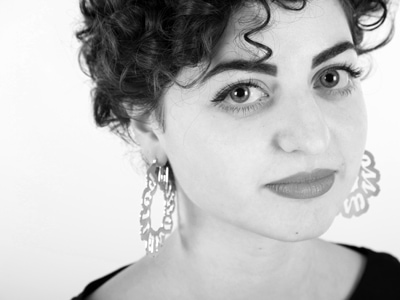Gallery Funaki in Melbourne, Australia, has a unique reputation in the Australian jewelry scene. Katie Scott, who now heads the gallery founded by Mari Funaki, answers some questions posed by Susan Cummins and Kamal Nassif.
Susan Cummins: For those who haven’t visited you in Melbourne, would you please give us a history of the gallery and its physical location and qualities?
Katie Scott: Mari Funaki opened Gallery Funaki in 1995. She had recently graduated from the metals program at RMIT University, and she wanted to establish a space that would show what she considered the best of international contemporary jewelry—pieces that hadn’t had an audience in Australia before—and show it in a way that really did the work justice. She also wanted to promote Australian jewelry in this context, placing it beside and showing its equality with the international movement. The gallery is located in a small lane in central Melbourne, an area known for its culture and history. It is a small, narrow space fitted out very simply with two long shelves as the exhibition space and a series of drawers in which pieces are kept. Mari felt it was important that the jewelry shouldn’t be behind glass but accessible to the hand and eye. People can really examine and interact with jewelry here in a way they can’t do anywhere else.
Kamal Nassif: Mari was both a maker and a gallerist. How do you feel this dual identity influenced her decisions as a gallerist?
Katie Scott: Mari approached the gallery very much from the perspective of a working artist. Her studio practice gave her a unique and very specific insight into how she ran her business, and she understood things implicitly from an artists’ point of view. That made her gallery a very sympathetic place for artists to exhibit. In terms of display, for instance, she always resisted showing a lot of work at once. Her aesthetic was always extremely minimal because she understood that each piece needed space. The level of perfection she insisted on when showing her own work naturally carried over to showing other artists’ work. Her dual practice also allowed her to talk with artists about jewelry and their work in a way that fostered close relationships and great respect.
Kamal Nassif: Can you speak more about absence of glass between the viewer and the work in Mari’s approach to display? Do you feel this changes the way viewers perceive work?
Katie Scott: We’ve become partially known for the absence of glass. It was simple aesthetic decision to a degree, because Mari didn’t like the look of glass cabinets. But, back in 1995 when the gallery opened, people in Melbourne really didn’t have much understanding of contemporary jewelry. Mari’s idea was that by allowing them to look at pieces from all angles, to pick them up and feel their weight, to relate in a direct, tactile way to the materials and texture, they would find contemporary jewelry exciting and accessible. There is an extent to which jewelry is inevitably deadened when it’s put behind glass. Jewelry, as we all relate like a mantra, is about the human body and human relationships. Allowing people to touch and look at it without glass as a mediator triggers people’s sense of their own involvement in that paradigm. It becomes inclusive rather than rarified and distanced. Certainly, many visitors to Gallery Funaki find the experience remarkable. Some are even quite terrified to open the drawers because they’re so unused to this freedom in a gallery. But, most take to it with utter glee.
Susan Cummins: Can you describe the role that Gallery Funaki played in bringing Australian jewelry to the attention of the world?
Katie Scott: Gallery Funaki was the first gallery to show Australian jewelry in an international context and in a gallery space rather than a shop. This elevated Australian jewelry in the eyes of the public. The gallery quickly established a significant reputation overseas. International artists and collectors appreciated the quality and originality of Australian work in a new way, too. Important Australian artists Carlier Makigawa and Marian Hosking had significant exhibitions early on, and their involvement meant the gallery had a reputation for excellence from the beginning. Mari also took Australian work overseas and promoted it in centers for contemporary jewelry such as Munich and Amsterdam. The Delicate Works exhibition at Galerie Ra, showing the work of Mari Funaki, Mascha Moje, and Marian Hosking, was a very important moment in the promotion of Australian jewelry to the world.
Kamal Nassif: How would you describe the Melbourne jewelry scene in an international context? What do you think are key qualities that identify works as Australian?
Katie Scott: That’s a tricky question. I’m not an expert on the Melbourne jewelry scene by any means. There are galleries here that specialize much more in that area. I would say that we have one of the most vibrant, active scenes in the world. We have university programs at Monash University and RMIT, excellent TAFE programs (all of which soldier on despite savage cuts in funding) and galleries that represent all points on the spectrum between commercial and art jewelry. That means there are a lot of makers and a lot of exposure to the craft here. I don’t think it’s going too far to say that contemporary jewelry is part of the city’s identity.
I honestly don’t believe that there are key qualities that distinguish Australian work from any other now, and I’d say that’s increasingly the case with any country. Contemporary jewelry is, though vibrant, a very small industry. Everyone sees everyone else’s work through gallery websites and online forums. While this has created an explosion of makers, exhibitions, and conversation, it has also tended to have a homogenizing effect overall I think.
Susan Cummins: How did you end up running the gallery? Are you now the owner?
Katie Scott: I started working at the gallery in 2005, during my third year at Monash University. I gradually took over the day-to-day management of the business as Mari devoted more time to working in her studio. Mari and I worked very closely together for five years, and towards the end of her life, she asked me to take over the gallery. I’m now the owner and director.
Susan Cummins: What is your background?
Katie Scott: I took a fairly circuitous route to get where I am. I worked in design, administration, and event management before starting a fine arts degree in metalsmithing at Monash University, under the supervision of Marian Hosking, Mascha Moje, and Simon Cottrell. After graduating in 2006, I worked part time as a jeweler and also at Gallery Funaki.
Susan Cummins: Can you describe the aesthetic vision of the gallery under Mari Funaki? Have you maintained the same vision?
Katie Scott: Mari had a very clear and uncompromising vision for both her gallery and her own art practice. She knew what she liked and what she didn’t. It was a subjective vision and unapologetically so. She had an extraordinary eye. Within seconds of looking at a piece, she could pinpoint its strengths and weaknesses and why it would or wouldn’t work in her gallery.
Kamal Nassif: Do you collaborate or interact with RMIT?
Katie Scott: Yes, we collaborate with RMIT in presenting lectures and workshops by visiting artists. We have a good, longstanding relationship with the institution, and their students are among the gallery’s most passionate followers. They bring so much energy and enthusiasm. They’re wonderful.
Thank you.
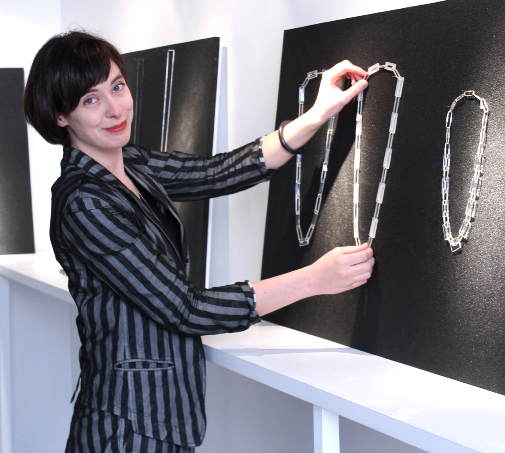
Susan Cummins: For those who haven’t visited you in Melbourne, would you please give us a history of the gallery and its physical location and qualities?
Katie Scott: Mari Funaki opened Gallery Funaki in 1995. She had recently graduated from the metals program at RMIT University, and she wanted to establish a space that would show what she considered the best of international contemporary jewelry—pieces that hadn’t had an audience in Australia before—and show it in a way that really did the work justice. She also wanted to promote Australian jewelry in this context, placing it beside and showing its equality with the international movement. The gallery is located in a small lane in central Melbourne, an area known for its culture and history. It is a small, narrow space fitted out very simply with two long shelves as the exhibition space and a series of drawers in which pieces are kept. Mari felt it was important that the jewelry shouldn’t be behind glass but accessible to the hand and eye. People can really examine and interact with jewelry here in a way they can’t do anywhere else.
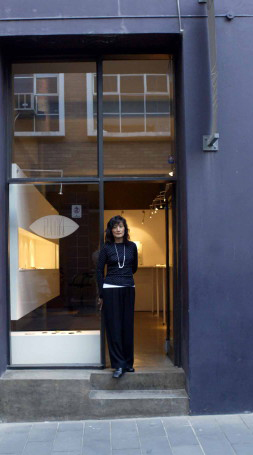
Katie Scott: Mari approached the gallery very much from the perspective of a working artist. Her studio practice gave her a unique and very specific insight into how she ran her business, and she understood things implicitly from an artists’ point of view. That made her gallery a very sympathetic place for artists to exhibit. In terms of display, for instance, she always resisted showing a lot of work at once. Her aesthetic was always extremely minimal because she understood that each piece needed space. The level of perfection she insisted on when showing her own work naturally carried over to showing other artists’ work. Her dual practice also allowed her to talk with artists about jewelry and their work in a way that fostered close relationships and great respect.
Kamal Nassif: Can you speak more about absence of glass between the viewer and the work in Mari’s approach to display? Do you feel this changes the way viewers perceive work?
Katie Scott: We’ve become partially known for the absence of glass. It was simple aesthetic decision to a degree, because Mari didn’t like the look of glass cabinets. But, back in 1995 when the gallery opened, people in Melbourne really didn’t have much understanding of contemporary jewelry. Mari’s idea was that by allowing them to look at pieces from all angles, to pick them up and feel their weight, to relate in a direct, tactile way to the materials and texture, they would find contemporary jewelry exciting and accessible. There is an extent to which jewelry is inevitably deadened when it’s put behind glass. Jewelry, as we all relate like a mantra, is about the human body and human relationships. Allowing people to touch and look at it without glass as a mediator triggers people’s sense of their own involvement in that paradigm. It becomes inclusive rather than rarified and distanced. Certainly, many visitors to Gallery Funaki find the experience remarkable. Some are even quite terrified to open the drawers because they’re so unused to this freedom in a gallery. But, most take to it with utter glee.

Susan Cummins: Can you describe the role that Gallery Funaki played in bringing Australian jewelry to the attention of the world?
Katie Scott: Gallery Funaki was the first gallery to show Australian jewelry in an international context and in a gallery space rather than a shop. This elevated Australian jewelry in the eyes of the public. The gallery quickly established a significant reputation overseas. International artists and collectors appreciated the quality and originality of Australian work in a new way, too. Important Australian artists Carlier Makigawa and Marian Hosking had significant exhibitions early on, and their involvement meant the gallery had a reputation for excellence from the beginning. Mari also took Australian work overseas and promoted it in centers for contemporary jewelry such as Munich and Amsterdam. The Delicate Works exhibition at Galerie Ra, showing the work of Mari Funaki, Mascha Moje, and Marian Hosking, was a very important moment in the promotion of Australian jewelry to the world.
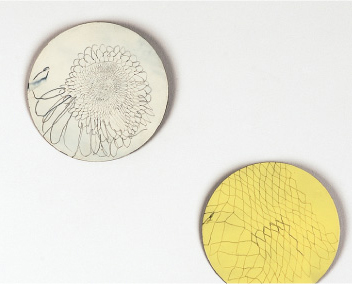
Katie Scott: That’s a tricky question. I’m not an expert on the Melbourne jewelry scene by any means. There are galleries here that specialize much more in that area. I would say that we have one of the most vibrant, active scenes in the world. We have university programs at Monash University and RMIT, excellent TAFE programs (all of which soldier on despite savage cuts in funding) and galleries that represent all points on the spectrum between commercial and art jewelry. That means there are a lot of makers and a lot of exposure to the craft here. I don’t think it’s going too far to say that contemporary jewelry is part of the city’s identity.
I honestly don’t believe that there are key qualities that distinguish Australian work from any other now, and I’d say that’s increasingly the case with any country. Contemporary jewelry is, though vibrant, a very small industry. Everyone sees everyone else’s work through gallery websites and online forums. While this has created an explosion of makers, exhibitions, and conversation, it has also tended to have a homogenizing effect overall I think.
Susan Cummins: How did you end up running the gallery? Are you now the owner?
Katie Scott: I started working at the gallery in 2005, during my third year at Monash University. I gradually took over the day-to-day management of the business as Mari devoted more time to working in her studio. Mari and I worked very closely together for five years, and towards the end of her life, she asked me to take over the gallery. I’m now the owner and director.
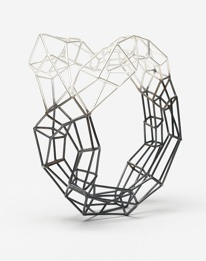
Katie Scott: I took a fairly circuitous route to get where I am. I worked in design, administration, and event management before starting a fine arts degree in metalsmithing at Monash University, under the supervision of Marian Hosking, Mascha Moje, and Simon Cottrell. After graduating in 2006, I worked part time as a jeweler and also at Gallery Funaki.
Susan Cummins: Can you describe the aesthetic vision of the gallery under Mari Funaki? Have you maintained the same vision?
Katie Scott: Mari had a very clear and uncompromising vision for both her gallery and her own art practice. She knew what she liked and what she didn’t. It was a subjective vision and unapologetically so. She had an extraordinary eye. Within seconds of looking at a piece, she could pinpoint its strengths and weaknesses and why it would or wouldn’t work in her gallery.
Kamal Nassif: Do you collaborate or interact with RMIT?
Katie Scott: Yes, we collaborate with RMIT in presenting lectures and workshops by visiting artists. We have a good, longstanding relationship with the institution, and their students are among the gallery’s most passionate followers. They bring so much energy and enthusiasm. They’re wonderful.
Thank you.

